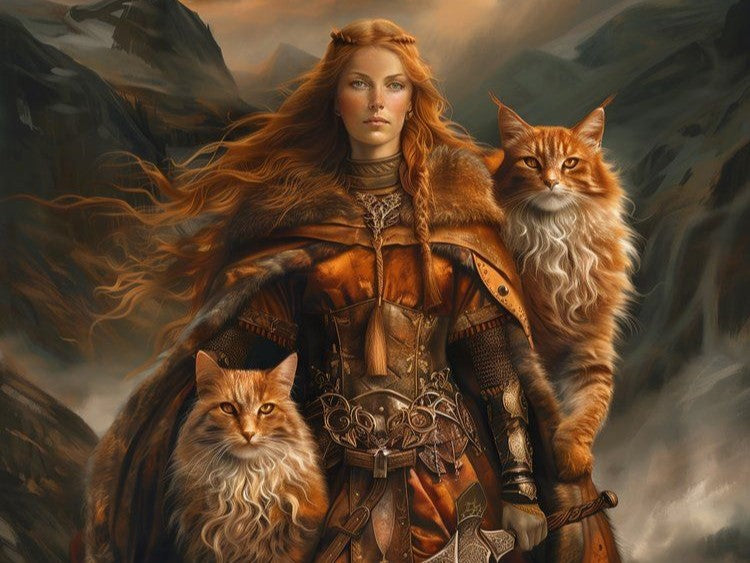Bygul and Trjegul are the mythical cats that accompany the Goddess Freya. These large gray or blue male cats – color varies from source to source – are known for their loyalty and their ability to pull Freyja’s chariot across the sky.
Bygul and Trjegul are mentioned in several sources, including the Prose Edda and the Poetic Edda, and it is said that the Goddess Freyja received both cats as a gift from Thor.

According to the stories, one day while Thor was fishing, he heard a beautiful singing that lulled him to sleep. Soon enough though, he was awakened by a horrible noise. Irritated, he went in search of the noise and came upon the magic Cat Bayun and two blue kittens. The kittens were asleep, and the cat, a male, was singing to them.
Thor asked if Cat Bayun was the kittens’ father, and the cat replied that he was. He’d met a pretty female in the spring and together they’d had these kittens, but now their mother had left him and he was stuck as a single father. He asked for Thor’s help, and Thor got the idea to give the kittens to Freya.

Bayun eagerly agreed, then turned into a bird and flew away, while Thor gathered up the kittens and took them to Freya. Those kittens grew into the cats that pull Freya’s chariot through the skies.
Bygul and Trjegul are important symbols of Norse culture. They represented loyalty, strength, and protection, which were highly valued by the Norse people. The Norse always believed in the power of animals and their spiritual significance.
Bygul and Trjegul also played an important role in Norse art and literature. They were often depicted in carvings, paintings, and other forms of art, and were mentioned in many Norse sagas and poems.

The pendant representing Freyja was found in Hagebyhöga, Sweden. On display in the Swedish Museum of National Antiquities in Stockholm
It was a tradition in the Viking culture to give a kitten (or more) to the newly wed, symbolizing the blessings of Freya for the couple.
While the cats appear in Prose Eda, specifically during the funeral of Balder, their names actually have modern origins, and are attributed to the American author Diana Paxton.
Sources
Simek, Rudolf. 1993. Dictionary of Northern Mythology. Translated by Angela Hall. ISBN-10 0859915131
Jesse Byock (2005) Snorri Sturluson, The Prose Edda. 1st. edition. London, England: Penguin Books Ltd. ISBN-13 978-0-140-44755-2
Anthony Faulkes (1995) Snorri Sturluson, Edda. 3rd. edition. London, England: Everyman J. M. Dent. ISBN-13 978-0-4608-7616-2














Comments (7)
Who painted the image of Freya and the ginger cats?
Can you, please, tell me who painted the first image of Freyja and the ginger cats?
Freyja really do just be sending everybody cats. I asked for her her help last year and she sent me SEVEN more cats to make a grand total of NINE! I’ve been rehoming them gradually and will end up with the three bonded to me specifically: my old gray tom who originally claimed me when I was 17, a black kitten with a white patches and his brother, a white kitten with black patches. The two little ones are completely opposite personality wise (one being a complete chaos gremlin who constantly needs to be held and the other being very zen and unobtrusive), and they’ve taken to mirroring the behaviors of my old gray boy. They all follow me around like little attendants with one or two keeping a lookout at all times. I feel like I have fuzzy bodyguards.